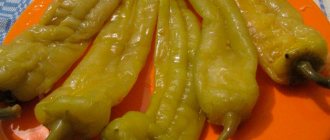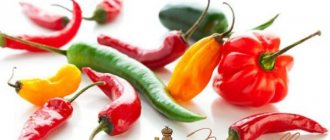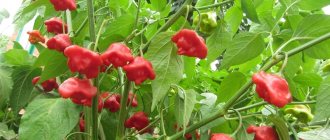History of Hungarian Paprika
Hungarians still have no consensus on how hot peppers came to them. Yes, yes, it’s spicy, although Hungarian Paprika is famous for its sweetness and aroma. The thing is that initially, all red capsicums, whose homeland is Central America, are naturally spicy and only when they got to Europe, thanks to the temperate climate, fertile soil and selection, it was possible to develop sweet varieties, the standard of which is, of course, the Bulgarian pepper.
But let's return to how chili peppers came to Hungary. And it most likely came in two ways: from Spain, where it was brought in 1492 by Columbus from America he discovered, and Turkey, to which at the beginning of the 16th century it was brought by traders who paved the way to Northern Europe from India, where pepper (brought from the same Central America) have already been grown. After all, Hungary was part of the Ottoman Empire for 192 years from 1526 to 1718. To this day, Pimento peppers grown in Spain (from which Spanish paprika is made) are identical to the Central American plant, while Hungarian paprika is more closely related to pepper varieties cultivated in India with smaller fruits but a particularly distinctive aroma.
While the Turks remained in the country, the Hungarians were not very interested in Turkish pepper. At first it was considered an ornamental plant and was used to decorate the gardens of the nobility. Then the shepherds, who had closer contact with the invaders, began to season their dishes with fire powder. It was only after their expulsion that ground pepper began to be introduced into village cuisine, and the Hungarian peasants appreciated beef and pork stews cooked with paprika sauce and recognized its final right to existence. Following them, the aristocrats found peasant food seasoned with red spice very attractive and gradually began to eat it.
Pepper was first mentioned in 1604 in the dictionary of Albert Shenzi Molnár (Hungarian pastor, linguist, translator), under the name “Turkish pepper”, and the first known recipe from it can be found in the cookbook of Istvan Nanasi from 1771. This is how he describes pickled Turkish pepper. “Collected at a weak green age, boil it in hot water, leave it overnight, taste it in the morning, if it is very strong, boil it again for half a day, then half a day in cold water (stand), then pierce it with a fork and put it together with caraway-like leaves, like cucumbers " As a medicinal drug, hot pepper was used in the form of infusions and ointments, and during the cholera epidemic of 1831 it was used as a prophylactic. At the same time, he began to appear more and more often in the kitchens of Hungarian families.
The modern Hungarian word paprika is clearly of Slavic origin - it is a corruption of the Latin piper, which came to the Hungarians through the Bulgarians, which, by the way, is why we call large sweet peppers “Bulgarian”. Paprika and similar words, peperke, piperke and paparka, are used in various Slavic languages to refer to sweet peppers.
How to choose the right hot pepper seeds?
The hotness of pepper is determined by the presence of a special chemical compound in its pulp - capsaicin, and in general, the severity is assessed on the Scoville scale. The more units a variety receives, the higher its pungency will be. The product is evaluated at the stage of its biological maturity; moreover, unripe fruits have not yet gained full pungency.
In general, breeders note that the overall pungency is directly influenced not only by the pepper variety, but also by the conditions in which it is grown. In particular, in order for the fruits to gain the spiciness corresponding to that declared by the manufacturer, you will have to follow certain rules: the pepper must be watered regularly. Even if it grows in greenhouse conditions, it is necessary to ensure high-quality air exchange. In addition, the temperature regime should be observed - this cannot be done in open ground conditions, but in a greenhouse it is quite acceptable to maintain the temperature at 25-27 degrees.
The best varieties of hot peppers, how to grow and care for them.
Pepper varieties differ from each other in a number of ways. In particular, in terms of the size of the bushes. Compact and low-growing plants are usually planted on window sills and in greenhouses, but some gardeners also use them for open ground, as they can significantly save space on the site. There are spreading and rather tall varieties that will have to be tied up so that they do not fall under the weight of the fruit.
A very important advantage of some varieties of this crop is the ability to easily tolerate shade, unlike, say, cucumbers or carrots. This means that beds with hot peppers can be located directly under trees, in the area of blind fences, and so on. You should also take into account the fact that the pungency of the fruit will change from year to year - this depends on many factors: the amount of moisture and minerals in the soil, general care, fertilizing, and so on.
When we selected products for inclusion in the rating of the best hot pepper seeds, we were, first of all, based on all the factors discussed above and on the pungency of ripe fruits. We have carefully analyzed a huge number of user reviews - in the review you will not find low-quality or untested crops.
Production of Hungarian Paprika
The majority of Hungarian paprika has historically been grown in two areas - near the cities of Kalocsa and Szeged. It was these areas of Hungary that flourished during the rule of the Ottoman Empire, being part of the Principality of Transylvania. It is believed that these regions have the best combination of soil and climatic conditions for obtaining the highest quality spices.
Seeds are sown in March and harvesting begins in the first week of September, completing fruit harvest by October. In centuries past, farmers harvested peppers by hand and hung bunches of pods in barns to dry. After some time, technological progress resulted in peppers being dried in large earthen ovens. Then they crushed the pepper with their feet, and then pounded it in large mortars. Later, stupas were replaced by water mills, and by the end of the 19th century, steam engines came to their aid.
But until the middle of the same 19th century, they did not know how to control the hotness of paprika. The unpredictability of the spiciness produced varying results in the final product, from fiery hot to moderately mild. Capsaicin, which gives paprika its pungency, is found mainly in the pod membranes and seeds, which are removed by hand when preparing the spice. In 1859, a machine for removing partitions and seeds was installed in Szeged by the Palfi brothers from Szeged, which made it possible to control the quality of the prepared paprika. Now the worker could adjust the spiciness by the amount of seeds left in the powder. This allowed the mass production of sweet peppers, which always had a larger market than hot varieties. Later, Ferenc Horvath and Jeno Obermaier from Kalocs entered into competition with Szeged and, through crossing, developed the world's first variety of pepper that does not have a spicy taste, and therefore does not require the removal of partitions and seeds.
Today, automatic machines do everything from sorting, washing, grinding to packaging, but many farmers still produce paprika powder at home, especially in villages on the Great Plain.
Sweet pepper Palanichko miracle
This variety is great for making lecho. This variety is not so easy to find, it is not very popular among summer residents. But it's worth looking for, it won't disappoint you for sure.
Palanichko brought the miracle to our country and neighboring countries from Serbia. Vegetable growers who grow this variety unanimously claim that without Palanichko, a miracle, the preparation of delicious lecho will not happen. Lecho made from this pepper is very similar in taste to popular Soviet products from Globus.
This variety has fairly thick walls (about one centimeter in thickness), the texture is fleshy, contains a large amount of sugars, and this pepper is very large in size. All these characteristics make pepper an ideal ingredient for lecho. But it is good not only as a twist for the winter, but also in a fresh version.
The variety is large-fruited, the pod is about 20 centimeters long, and its weight can reach as much as four hundred grams! The shape of the fruit is cone-shaped, pointed. It has a beautiful rich red color. When grown in an open area, the plants reach a height of about 40 - 70 centimeters. The shape is standard, the number of leaves is average. The variety produces quite a lot of fruits, so it is necessary to tie up the plants. You can harvest the crop in early August (if the seeds were sown in March). The second fruiting will most likely begin in September. There are a lot of ovaries in the second harvest, but the size of the peppers themselves is no longer so large.
Types of Hungarian Paprika
Today, to produce paprika, several varieties and hybrids of pepper are used in Hungary: - “Szentesi Cherry Pepper” with round fruits with a diameter of 2-3 cm and a spicy taste; — “Hirös F1” with large, hanging, fleshy fruits 16-18 cm long; — “Szegedi 179” with fruits 12-15 cm long, rich in red pigment; - “Kalocsai 662” with fruits 10-15 cm long, growing upward, with a sweet, mild taste and high pigment content, and others.
There are several types of Hungarian paprika, which differ in taste and color. The flavor ranges from spicy to sweet and smoky, and the color ranges from pale red to brownish-red.
Based on physicochemical and organoleptic properties, Hungarian paprika is officially divided into four types: special, gourmet, sweet and pink.
Based on the content of the alkaloid capsaicin, they are divided into non-acute (no more than 100 mg/kg), mildly acute (from 100 to 200 mg/kg) and acute (more than 200 mg/kg).
For domestic consumption, paprika is used that is hotter than that which is exported, and the main varieties are divided into even finer gradations.
If you buy homemade paprika at the market (which is usually sold in half-kilogram plastic bags without labeling), it will be either édes (mild paprika) or csipős (hot paprika)
In stores on the Balkan Peninsula, you can find 8 brands of spices, differing in color and spiciness depending on the varieties of peppers:
- Special quality (Különleges) - the softest of all, with a subtle fruity aroma. Consists only of the fruiting body, without seeds and partitions. The color is deep bright red;
- Tender (csípősmentes csemege) - soft with a rich taste, color from light red to dark red;
- Exquisitely gentle (csemege) - slightly spicier than “Tender”;
- Spicy exquisitely tender (csípős csemege), an even sharper version of tender, as it is ground together with seeds and partitions;
- Noble sweet (édesnemes) - the most common, most often exported variety, slightly spicy, bright red in color;
- Semi-sweet (félédes) - medium-hot, a mixture of mild and hot peppers;
- Rose (rózsa) - with a strong aroma and slight pungency; for its production, the pods are picked unripe. Color pale red, reddish;
- Hot (erős) is the hottest paprika, the color is light brown with an orange tint.
Similar varieties and hybrids
Among the varieties of hot pepper, Hungarian is the only one with a yellow color. However, this is not the only cultivar bred by breeders that is endowed with a semi-sharp taste. According to the characteristics of taste, Hungarian spicy is similar to:
- Vortex;
- Indian elephant;
- Cohiba F1.
Whirlwind is a variety with a semi-spreading and low bush (40-50cm). After emergence, it bears fruit at technical ripeness after 100 days. The mass of peppercorns is up to 40 g, the wall thickness is 4 mm. The variety is valued for its resistance to many diseases, long and abundant fruiting, and cold resistance. It can be used for pickles, making adjika and other culinary delights.
Indian elephant - semi-hot pepper from the Aelita agricultural company. Forms a harvest 120-130 days after the seeds hatch. The plant can grow more than 1 meter in height. The pods gain weight up to 25 g, while the wall thickness is 2 mm. The color of the fruit during the setting period is light green, which changes to dark red when ripe. Productivity – up to 3.5 kg per square meter. m. Can be used to prepare paprika.
Cohiba is a hybrid of early ripening Japanese breeders. In open ground the bush reaches medium height. Can be grown in greenhouses. Pepper pods reach a length of up to 22 cm, with an average weight of 50 g. The thickness of the pericarp is no more than 3 mm. The taste of the fruit is semi-sharp. The established pods are white with a greenish tint. When they reach full ripeness, the peppers are light red. The variety has shown resistance to tobacco mosaic virus. Ideal for pickling and fresh consumption.
What makes Hungarian pepper special?
Features of Hungarian Paprika
Favorable climatic conditions (abundance of sun, fertile soil) allowed Hungarian pepper to become the best in the world for the production of paprika. Thanks to its spicy and unique (from sweet to savory with a slight tangy) taste, it gives dishes an unattainable aroma, and many traditional Hungarian recipes are difficult to prepare without this spice.
To produce semi-hot and sweet paprika, seeds and seed walls are removed from the fruit, which reduces the pungency. Some manufacturers add hot chili peppers to paprika, as well as peppers grown in other countries, but this product cannot be called Hungarian paprika, which is regulated by law.
The best Hungarian pepper comes from the regions of Szeged and Kalocssy. These two cities are responsible for most of the production of paprika and spices of the highest quality. The best peppers from Kalocsa are called Kalocsa Aranya and are available in both savory and sweet varieties. Pepper grinds from Szeged are divided into three classes, the first of which indicates the best quality.
In addition to Hungarian paprika, Spanish paprika, which is made mainly from Pimento pepper varieties, is also popular in the world. Pimentón pepper is available in three varieties: mild (pimentón dulce), moderately spicy (pimentón agridulce) and spicy (pimentón picante). The most common Spanish paprika, Pimentón dela Ver, has a distinct smoky taste and aroma, as the pepper is dried by smoking, usually using oak wood. Pimentón de Murcia, another variety of paprika, the peppers for which are not smoked, but are traditionally dried in the sun or in ovens.
The main difference between Hungarian pepper and Spanish pepper, used to make paprika, is that Hungarian pepper is not smoked, but dried under natural conditions, so the powder prepared from it is much softer.
Sweet Marconi pepper purple
This variety is great for grilling. Marconi purple is very popular and successful in Italy. It comes in different colors. The red variety is very sweet and juicy, the yellow pepper has a softer and more restrained taste, and the purple one has a bright and pleasant aroma. In addition, the purple variety compares favorably with others with its unusual and elegant appearance.
The pepper also has an interesting shape that resembles purple icicles. The pepper is quite narrow and pointed. The texture of the pod is glossy and smooth. As a rule, the variety is fifteen centimeters in length and only 1.5 - 2.5 centimeters in width. The walls of the fruit are not thick (about four to six millimeters) and have an elastic and crispy texture. When the characteristic pepper aroma appears and the color turns deep burgundy, it means the pepper has reached its full maturity.
This variety requires very little attention, but at the same time shows excellent results in terms of yield. The bushes have a standard shape and reach a height of approximately 60 - 90 centimeters. The fruits can ripen right up to frost. For this variety, a garter is not required, since the pepper weighs quite little, and the base of the bush is powerful and lignified. The Marconi variety has a bright peppery aroma and delicate taste, so this pepper is perfect for preparing stews, fresh salads, and marinades. The fruits are also good for eating fresh, not even fully ripened.
In terms of ripening time, this variety is classified as early ripening; already 75 days after planting the seedlings in the ground, the harvest can be harvested. Also, thanks to the bright aroma and thin walls, it is fashionable to safely dry Marconi.
Paprikas in cooking.
Paprika symbolizes Hungarian cuisine and is an important component of the most famous national dishes, such as chicken paprikash (paprikás), goulash (pörkölt), fish soup (halászlé). It is added to the famous “winter salami” from Szeged (Téliszalámi), decorated with sandwiches, potato salads, omelettes, and added to confectionery to add color and flavor.
One Hungarian cooking technique that is the basis of traditional Hungarian cuisine is adding ground red pepper (not just a pinch, but a few heaping tablespoons) to diced onions, which are slowly fried in hot fat until translucent. Lard, onion and ground pepper, the so-called “Holy Trinity”, are the first step to countless Hungarian dishes.
A small bowl or shaker of pepper sits next to the salt on any Hungarian dinner table, and when you buy a half-kilo bag of pepper, you don't have to think twice about how to use it.
Seed selection
To get a good harvest, first of all, you should be very careful when choosing seeds, especially considering the fact that there are a huge number of them. Hot peppers can be grown equally successfully in open ground, in greenhouses and greenhouses, as well as on the balcony.
What should not be forgotten for seeds of different varieties:
- Climatic conditions affect the heat of the fruit: if they grow in a dry and cool climate, the heat will not be as strong compared to peppers grown in more humid and hot conditions.
- It is recommended to germinate the seeds on wet wipes in advance; without this step, the time for the first shoots to appear may take from 2 to 4 weeks.
- When planting, it is imperative to maintain the correct distance between plants, since the lack of sunlight will negatively affect the future harvest.
- For cultivation in open ground, it is better to choose seed material of early ripeness in order to have time to harvest before the first frost.
- For foreign selection, there is an SHU or Scoville measure of acuteness. This indicator will tell you how sharp the pods will be.
- Rare varieties can be found in specialized stores or from connoisseurs and collectors.
Germinating hot pepper seeds
How to cook paprika.
Making paprika yourself at home is not difficult. It is more difficult to decide on the choice of pepper, which should have the following distinctive features from other chili peppers: - it should be sweet or moderately spicy-spicy; - have a wonderful aroma; — the walls of the fetus should be thin. I would like to draw your attention to the last feature: if the walls of the pepper are thick, it will not dry well and even become moldy. Therefore, sweet and aromatic bell peppers are not suitable for these purposes.
For myself, I chose the following varieties of peppers: Sweet Cayenne, Engraved Macedonian and Pasillo Baggio. At my summer cottage last summer I tried two of the three varieties - Cayenne and Macedonian. The result exceeded all my expectations, both in terms of yield and taste. I simply dried the Sweet Cayenne in a garland in the kitchen and ground it into paprika, and I smoked the Engraved Macedonian, dried it, broke it into flakes and in the winter I prepared a wonderful sauce “Macedonian with smoky smoked peppers.”
The process of drying and smoking peppers is not at all complicated and it is enough to look at my articles “How to dry chili peppers” and “How to smoke hot peppers at home” to refresh your knowledge on this issue.
Landing
Sowing work is carried out from mid-February until the end of March. Before germination, the temperature is maintained at 25-28 degrees, greenhouse conditions are created (covered with film). After germination, the seedlings are kept warm - 25 degrees during the day, 16-18 degrees at night. Water carefully with a syringe or spray bottle so as not to wash away the seedlings.
Before and after diving, the seedlings are fed with an organic-based solution (bio-infusion, mullein). Ready-made complex mixtures – Agricola, Malyshok, Dobrivo – enhance the power of seedlings.
50-65 day old sprouts are hardened off for 10-12 days and planted in permanent beds.
Edible souvenirs from Budapest
Many people like to bring something tasty from abroad. Personally, after the introduction of sanctions, the question of what to bring from Budapest as a gift practically disappeared. Many friends, as soon as they learn that I am going from Budapest to Russia, send orders for cheeses, sausages and even seasonings. So there is no need to rack your brains. The word “sanction”, it seems, has seriously and for a long time entered our verbal usage, so first I’ll tell you in detail about edible souvenirs from Budapest.
Paprika - for spicy lovers and not only
Paprika - ground red pepper is considered an integral part of Hungarian cuisine. To make it, the core and seeds are removed from the pepper pods, and the dried pulp is ground into powder. Today, seven types of ground red pepper are produced in Hungary
- Particularly acute (csipossegmentes).
- Spicy (kulonleges).
- Semi-sweet (fel-edes).
- Sweet-noble (edes-nemes).
- Pink (rozsa).
- Acute (eros).
- Gastronomic (csemege).
In addition to edible peppers, in Hungary you can also buy garlands made from dried red peppers. You can decorate your kitchen with these garlands.
Modern Hungarian cuisine is also incomplete without pepper. It is very difficult to find dishes in which it is not added. The only exception is desserts. Here, you will agree, the presence of pepper is not at all appropriate. So a pinch of Hungarian paprika, added to the dish at home, will refresh the memories of your trip to Budapest.
Where can I buy?
Paprika is sold in all supermarkets in Budapest. You will find more beautifully decorated options - in canvas bags - in souvenir shops. They will naturally cost more. My favorite paprika is sold in Aldi supermarkets. This is not exactly paprika, but rather a seasoning with paprika in its composition, but I still highly recommend trying it. Manufacturer Le Gusto, name - paprikás-hagymás. I add it to almost all dishes - from meat to vegetables.
Paprika seasonings are also sold in the form of pastes. Look carefully at the packaging so as not to make a mistake with the taste. Csípős and Erős - hot pepper paste. Édes - sweet.
Wine - Tokaj, Egri Bikaver and much more
Eger and Tokaj are two of Hungary's most famous wine regions in the world. But there are actually many more of them.
Tokaj is famous for the production of dessert and semi-sweet wines, Eger - dry. In the Tokaj region, Asu is considered the best - a dessert wine made from grapes that have begun to raisin and are affected by a special mold botrytis cinerea.
These grapes are collected in “puttoni” - special containers. And only after fermentation has reached the desired stage, it is mixed with the main composition.
The number of containers used in the process determines the class of wine. The more there are, the more expensive and sweeter the wine. Dry wines from the Tokaj region taste very pleasant, but dessert wines are still more popular.
The most famous wine of the Eger region is the dry red Egri bikavér (Bull's blood). Many legends are associated with this wine. According to one of them, such an unusual name for wine was assigned during the struggle of the Hungarians with the Turks. The latter were besieging one of the Hungarian fortresses and saw the soldiers drinking something from cups, after which they got a second wind. The conquerors decided that the Hungarians were “recharged” with the blood of a bull. Modern "Bull's Blood" consists of a mixture of several varieties of local and international grapes in different proportions.
Pink - look for the inscription Kékfrankos (Kekfrankos) on the bottle and feel free to take it if the wine costs from 1,500 forints. Kekfrankosh is supposed to be a red wine variety, but I love it in its rosé version. And I recommend that you try it, and also take it with you as souvenirs from Budapest.
Hungarian winemaking is not limited to the three or four wines that many people hear. In the territory of a small country, more than 20 regions are considered wine-producing regions. I prefer to take wines from the regions of Villány, Szekszárd and Badacsony.
Lifehack. If you only have hand luggage, you won't be able to buy wine at the supermarket. But don't forget about duty free at Budapest airport. Wines from a good producer, Vylyan, are sold there on an ongoing basis. My recommendations: pink Kakas (with a rooster on the label) and red Ördög (with a devil).
Palinka – for those who like it stronger
Palinka is a fruit brandy, or, quite simply, an analogue of Russian vodka. A strong drink is prepared from plums, apples, quinces, and pears. A similar fruit brandy is loved and produced in many countries neighboring Hungary, but only Hungarian producers have the right to call it “palinka”. The fruit base gives the drink softness and aroma. The strength of the drink is 37.5% or more, but, nevertheless, it is easy to drink. And I confirm it











